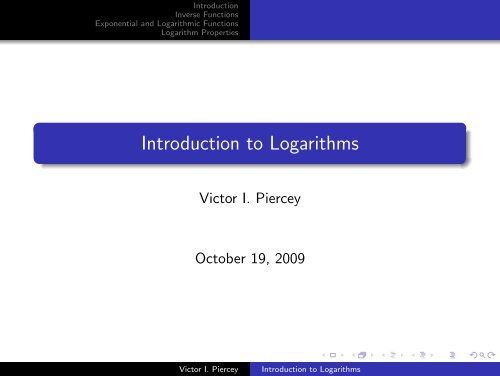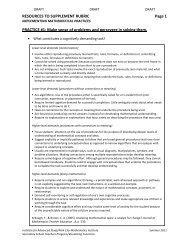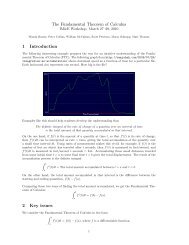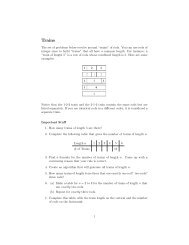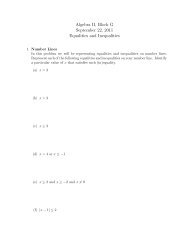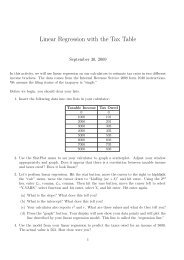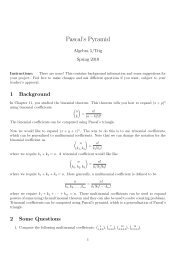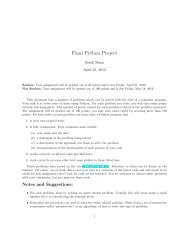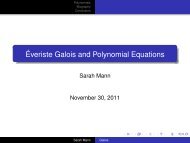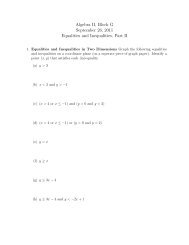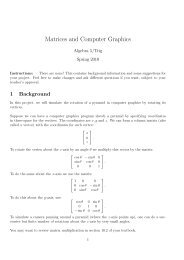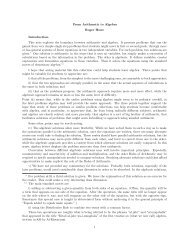Introduction to Logarithms
Introduction to Logarithms
Introduction to Logarithms
Create successful ePaper yourself
Turn your PDF publications into a flip-book with our unique Google optimized e-Paper software.
<strong>Introduction</strong><br />
Inverse Functions<br />
Exponential and Logarithmic Functions<br />
Logarithm Properties<br />
<strong>Introduction</strong> <strong>to</strong> <strong>Logarithms</strong><br />
Vic<strong>to</strong>r I. Piercey<br />
Oc<strong>to</strong>ber 19, 2009<br />
Vic<strong>to</strong>r I. Piercey <strong>Introduction</strong> <strong>to</strong> <strong>Logarithms</strong>
<strong>Introduction</strong><br />
Inverse Functions<br />
Exponential and Logarithmic Functions<br />
Logarithm Properties<br />
Motivation: My Senior Thesis<br />
In my senior thesis, I wanted <strong>to</strong> estimate productivity in the<br />
Russian defense sec<strong>to</strong>r in the mid-1990’s.<br />
In particular I wanted <strong>to</strong> test for “Cobb-Douglas” production<br />
technology:<br />
Q = AL β1 K β2<br />
where Q is output, L is the amount of labor input, K is the<br />
amount of capital input, and A, β1, β2 are productivity parameters.<br />
I had data for Q, L and K and wanted <strong>to</strong> run regression.<br />
Problem: The Cobb-Douglas production function is not linear!<br />
Vic<strong>to</strong>r I. Piercey <strong>Introduction</strong> <strong>to</strong> <strong>Logarithms</strong>
<strong>Introduction</strong><br />
Inverse Functions<br />
Exponential and Logarithmic Functions<br />
Logarithm Properties<br />
Motivation: My Senior Thesis<br />
In my senior thesis, I wanted <strong>to</strong> estimate productivity in the<br />
Russian defense sec<strong>to</strong>r in the mid-1990’s.<br />
In particular I wanted <strong>to</strong> test for “Cobb-Douglas” production<br />
technology:<br />
Q = AL β1 K β2<br />
where Q is output, L is the amount of labor input, K is the<br />
amount of capital input, and A, β1, β2 are productivity parameters.<br />
I had data for Q, L and K and wanted <strong>to</strong> run regression.<br />
Problem: The Cobb-Douglas production function is not linear!<br />
Vic<strong>to</strong>r I. Piercey <strong>Introduction</strong> <strong>to</strong> <strong>Logarithms</strong>
<strong>Introduction</strong><br />
Inverse Functions<br />
Exponential and Logarithmic Functions<br />
Logarithm Properties<br />
Motivation: My Senior Thesis<br />
In my senior thesis, I wanted <strong>to</strong> estimate productivity in the<br />
Russian defense sec<strong>to</strong>r in the mid-1990’s.<br />
In particular I wanted <strong>to</strong> test for “Cobb-Douglas” production<br />
technology:<br />
Q = AL β1 K β2<br />
where Q is output, L is the amount of labor input, K is the<br />
amount of capital input, and A, β1, β2 are productivity parameters.<br />
I had data for Q, L and K and wanted <strong>to</strong> run regression.<br />
Problem: The Cobb-Douglas production function is not linear!<br />
Vic<strong>to</strong>r I. Piercey <strong>Introduction</strong> <strong>to</strong> <strong>Logarithms</strong>
<strong>Introduction</strong><br />
Inverse Functions<br />
Exponential and Logarithmic Functions<br />
Logarithm Properties<br />
Motivation: My Senior Thesis<br />
In my senior thesis, I wanted <strong>to</strong> estimate productivity in the<br />
Russian defense sec<strong>to</strong>r in the mid-1990’s.<br />
In particular I wanted <strong>to</strong> test for “Cobb-Douglas” production<br />
technology:<br />
Q = AL β1 K β2<br />
where Q is output, L is the amount of labor input, K is the<br />
amount of capital input, and A, β1, β2 are productivity parameters.<br />
I had data for Q, L and K and wanted <strong>to</strong> run regression.<br />
Problem: The Cobb-Douglas production function is not linear!<br />
Vic<strong>to</strong>r I. Piercey <strong>Introduction</strong> <strong>to</strong> <strong>Logarithms</strong>
<strong>Introduction</strong><br />
Inverse Functions<br />
Exponential and Logarithmic Functions<br />
Logarithm Properties<br />
Inverse Functions<br />
If a function f takes inputs <strong>to</strong> outputs, its inverse function reverses<br />
the relationship.<br />
For example, if given your income, the function tells you your taxes<br />
owed - what would the inverse function do?<br />
Vic<strong>to</strong>r I. Piercey <strong>Introduction</strong> <strong>to</strong> <strong>Logarithms</strong>
<strong>Introduction</strong><br />
Inverse Functions<br />
Exponential and Logarithmic Functions<br />
Logarithm Properties<br />
Inverse Functions<br />
If a function f takes inputs <strong>to</strong> outputs, its inverse function reverses<br />
the relationship.<br />
For example, if given your income, the function tells you your taxes<br />
owed - what would the inverse function do?<br />
Vic<strong>to</strong>r I. Piercey <strong>Introduction</strong> <strong>to</strong> <strong>Logarithms</strong>
<strong>Introduction</strong><br />
Inverse Functions<br />
Exponential and Logarithmic Functions<br />
Logarithm Properties<br />
Finding Inverse Functions<br />
If your function is given by a formula y = f (x), the formula for the<br />
inverse function is accomplished by switching x and y (hence<br />
switching inputs and outputs) and solving for y.<br />
For example: find the inverse of the function f (x) = 2x + 8.<br />
Vic<strong>to</strong>r I. Piercey <strong>Introduction</strong> <strong>to</strong> <strong>Logarithms</strong>
<strong>Introduction</strong><br />
Inverse Functions<br />
Exponential and Logarithmic Functions<br />
Logarithm Properties<br />
Finding Inverse Functions<br />
If your function is given by a formula y = f (x), the formula for the<br />
inverse function is accomplished by switching x and y (hence<br />
switching inputs and outputs) and solving for y.<br />
For example: find the inverse of the function f (x) = 2x + 8.<br />
Vic<strong>to</strong>r I. Piercey <strong>Introduction</strong> <strong>to</strong> <strong>Logarithms</strong>
<strong>Introduction</strong><br />
Inverse Functions<br />
Exponential and Logarithmic Functions<br />
Logarithm Properties<br />
Exponential Functions<br />
The equation y = 2 x defines a function. We can plug in values and<br />
graph this function if we like.<br />
More generally, if 0 < b < 1 or b > 1, then the equation y = b x<br />
defines a function, called the exponential function of base b.<br />
The most common bases are b = e and b = 10.<br />
Try and find the inverse function for y = 2 x .<br />
Vic<strong>to</strong>r I. Piercey <strong>Introduction</strong> <strong>to</strong> <strong>Logarithms</strong>
<strong>Introduction</strong><br />
Inverse Functions<br />
Exponential and Logarithmic Functions<br />
Logarithm Properties<br />
Exponential Functions<br />
The equation y = 2 x defines a function. We can plug in values and<br />
graph this function if we like.<br />
More generally, if 0 < b < 1 or b > 1, then the equation y = b x<br />
defines a function, called the exponential function of base b.<br />
The most common bases are b = e and b = 10.<br />
Try and find the inverse function for y = 2 x .<br />
Vic<strong>to</strong>r I. Piercey <strong>Introduction</strong> <strong>to</strong> <strong>Logarithms</strong>
<strong>Introduction</strong><br />
Inverse Functions<br />
Exponential and Logarithmic Functions<br />
Logarithm Properties<br />
Exponential Functions<br />
The equation y = 2 x defines a function. We can plug in values and<br />
graph this function if we like.<br />
More generally, if 0 < b < 1 or b > 1, then the equation y = b x<br />
defines a function, called the exponential function of base b.<br />
The most common bases are b = e and b = 10.<br />
Try and find the inverse function for y = 2 x .<br />
Vic<strong>to</strong>r I. Piercey <strong>Introduction</strong> <strong>to</strong> <strong>Logarithms</strong>
<strong>Introduction</strong><br />
Inverse Functions<br />
Exponential and Logarithmic Functions<br />
Logarithm Properties<br />
Exponential Functions<br />
The equation y = 2 x defines a function. We can plug in values and<br />
graph this function if we like.<br />
More generally, if 0 < b < 1 or b > 1, then the equation y = b x<br />
defines a function, called the exponential function of base b.<br />
The most common bases are b = e and b = 10.<br />
Try and find the inverse function for y = 2 x .<br />
Vic<strong>to</strong>r I. Piercey <strong>Introduction</strong> <strong>to</strong> <strong>Logarithms</strong>
<strong>Introduction</strong><br />
Inverse Functions<br />
Exponential and Logarithmic Functions<br />
Logarithm Properties<br />
<strong>Logarithms</strong><br />
There is an inverse function, but ordinary algebra will not help find<br />
it.<br />
Instead, we invent notation <strong>to</strong> define the inverse function:<br />
y = log 2(x).<br />
By definition, log b(x) = y means b y = x.<br />
This is the logarithm with base b.<br />
Vic<strong>to</strong>r I. Piercey <strong>Introduction</strong> <strong>to</strong> <strong>Logarithms</strong>
<strong>Introduction</strong><br />
Inverse Functions<br />
Exponential and Logarithmic Functions<br />
Logarithm Properties<br />
<strong>Logarithms</strong><br />
There is an inverse function, but ordinary algebra will not help find<br />
it.<br />
Instead, we invent notation <strong>to</strong> define the inverse function:<br />
y = log 2(x).<br />
By definition, log b(x) = y means b y = x.<br />
This is the logarithm with base b.<br />
Vic<strong>to</strong>r I. Piercey <strong>Introduction</strong> <strong>to</strong> <strong>Logarithms</strong>
<strong>Introduction</strong><br />
Inverse Functions<br />
Exponential and Logarithmic Functions<br />
Logarithm Properties<br />
<strong>Logarithms</strong><br />
There is an inverse function, but ordinary algebra will not help find<br />
it.<br />
Instead, we invent notation <strong>to</strong> define the inverse function:<br />
y = log 2(x).<br />
By definition, log b(x) = y means b y = x.<br />
This is the logarithm with base b.<br />
Vic<strong>to</strong>r I. Piercey <strong>Introduction</strong> <strong>to</strong> <strong>Logarithms</strong>
<strong>Introduction</strong><br />
Inverse Functions<br />
Exponential and Logarithmic Functions<br />
Logarithm Properties<br />
<strong>Logarithms</strong><br />
There is an inverse function, but ordinary algebra will not help find<br />
it.<br />
Instead, we invent notation <strong>to</strong> define the inverse function:<br />
y = log 2(x).<br />
By definition, log b(x) = y means b y = x.<br />
This is the logarithm with base b.<br />
Vic<strong>to</strong>r I. Piercey <strong>Introduction</strong> <strong>to</strong> <strong>Logarithms</strong>
<strong>Introduction</strong><br />
Inverse Functions<br />
Exponential and Logarithmic Functions<br />
Logarithm Properties<br />
Practice Computing Some <strong>Logarithms</strong><br />
For practice, let’s compute the following:<br />
1 log 2(4)<br />
2 log 3(27)<br />
3 log 7<br />
<br />
1<br />
7<br />
4 log b(1) for any base b<br />
Vic<strong>to</strong>r I. Piercey <strong>Introduction</strong> <strong>to</strong> <strong>Logarithms</strong>
<strong>Introduction</strong><br />
Inverse Functions<br />
Exponential and Logarithmic Functions<br />
Logarithm Properties<br />
Practice Computing Some <strong>Logarithms</strong><br />
For practice, let’s compute the following:<br />
1 log 2(4)<br />
2 log 3(27)<br />
3 log 7<br />
<br />
1<br />
7<br />
4 log b(1) for any base b<br />
Vic<strong>to</strong>r I. Piercey <strong>Introduction</strong> <strong>to</strong> <strong>Logarithms</strong>
<strong>Introduction</strong><br />
Inverse Functions<br />
Exponential and Logarithmic Functions<br />
Logarithm Properties<br />
Practice Computing Some <strong>Logarithms</strong><br />
For practice, let’s compute the following:<br />
1 log 2(4)<br />
2 log 3(27)<br />
3 log 7<br />
<br />
1<br />
7<br />
4 log b(1) for any base b<br />
Vic<strong>to</strong>r I. Piercey <strong>Introduction</strong> <strong>to</strong> <strong>Logarithms</strong>
<strong>Introduction</strong><br />
Inverse Functions<br />
Exponential and Logarithmic Functions<br />
Logarithm Properties<br />
Practice Computing Some <strong>Logarithms</strong><br />
For practice, let’s compute the following:<br />
1 log 2(4)<br />
2 log 3(27)<br />
3 log 7<br />
<br />
1<br />
7<br />
4 log b(1) for any base b<br />
Vic<strong>to</strong>r I. Piercey <strong>Introduction</strong> <strong>to</strong> <strong>Logarithms</strong>
<strong>Introduction</strong><br />
Inverse Functions<br />
Exponential and Logarithmic Functions<br />
Logarithm Properties<br />
Special Logs<br />
The base b = e occurs frequently in nature, so the logarithm with<br />
base e is called the natural log and it is denoted ln(x).<br />
The base b = 10 is very common, so it is called the common log<br />
and is denoted log(x), with the base suppressed.<br />
These are the only logarithms that can be computed on your<br />
calcula<strong>to</strong>r (without using the change of base formula).<br />
Vic<strong>to</strong>r I. Piercey <strong>Introduction</strong> <strong>to</strong> <strong>Logarithms</strong>
<strong>Introduction</strong><br />
Inverse Functions<br />
Exponential and Logarithmic Functions<br />
Logarithm Properties<br />
Special Logs<br />
The base b = e occurs frequently in nature, so the logarithm with<br />
base e is called the natural log and it is denoted ln(x).<br />
The base b = 10 is very common, so it is called the common log<br />
and is denoted log(x), with the base suppressed.<br />
These are the only logarithms that can be computed on your<br />
calcula<strong>to</strong>r (without using the change of base formula).<br />
Vic<strong>to</strong>r I. Piercey <strong>Introduction</strong> <strong>to</strong> <strong>Logarithms</strong>
<strong>Introduction</strong><br />
Inverse Functions<br />
Exponential and Logarithmic Functions<br />
Logarithm Properties<br />
Special Logs<br />
The base b = e occurs frequently in nature, so the logarithm with<br />
base e is called the natural log and it is denoted ln(x).<br />
The base b = 10 is very common, so it is called the common log<br />
and is denoted log(x), with the base suppressed.<br />
These are the only logarithms that can be computed on your<br />
calcula<strong>to</strong>r (without using the change of base formula).<br />
Vic<strong>to</strong>r I. Piercey <strong>Introduction</strong> <strong>to</strong> <strong>Logarithms</strong>
<strong>Introduction</strong><br />
Inverse Functions<br />
Exponential and Logarithmic Functions<br />
Logarithm Properties<br />
Properties of Exponents<br />
The reason logarithms are so important is because of their<br />
properties, which come from properties of exponents.<br />
The following are the properties of exponents:<br />
1 b n+m = b n b m<br />
2 b n−m = bn<br />
b m<br />
3 (b n ) m = b nm .<br />
Vic<strong>to</strong>r I. Piercey <strong>Introduction</strong> <strong>to</strong> <strong>Logarithms</strong>
<strong>Introduction</strong><br />
Inverse Functions<br />
Exponential and Logarithmic Functions<br />
Logarithm Properties<br />
Properties of Exponents<br />
The reason logarithms are so important is because of their<br />
properties, which come from properties of exponents.<br />
The following are the properties of exponents:<br />
1 b n+m = b n b m<br />
2 b n−m = bn<br />
b m<br />
3 (b n ) m = b nm .<br />
Vic<strong>to</strong>r I. Piercey <strong>Introduction</strong> <strong>to</strong> <strong>Logarithms</strong>
<strong>Introduction</strong><br />
Inverse Functions<br />
Exponential and Logarithmic Functions<br />
Logarithm Properties<br />
Properties of Exponents<br />
The reason logarithms are so important is because of their<br />
properties, which come from properties of exponents.<br />
The following are the properties of exponents:<br />
1 b n+m = b n b m<br />
2 b n−m = bn<br />
b m<br />
3 (b n ) m = b nm .<br />
Vic<strong>to</strong>r I. Piercey <strong>Introduction</strong> <strong>to</strong> <strong>Logarithms</strong>
<strong>Introduction</strong><br />
Inverse Functions<br />
Exponential and Logarithmic Functions<br />
Logarithm Properties<br />
Properties of Exponents<br />
The reason logarithms are so important is because of their<br />
properties, which come from properties of exponents.<br />
The following are the properties of exponents:<br />
1 b n+m = b n b m<br />
2 b n−m = bn<br />
b m<br />
3 (b n ) m = b nm .<br />
Vic<strong>to</strong>r I. Piercey <strong>Introduction</strong> <strong>to</strong> <strong>Logarithms</strong>
<strong>Introduction</strong><br />
Inverse Functions<br />
Exponential and Logarithmic Functions<br />
Logarithm Properties<br />
Properties of <strong>Logarithms</strong><br />
Since logarithms are inverses of exponential functions, one can<br />
invert the properties of exponents <strong>to</strong> obtain the following<br />
properties:<br />
1 log b(MN) = log b(M) + log b(N)<br />
2 log b<br />
<br />
M<br />
= log<br />
N<br />
b(M) − logb(N) 3 log b(M p ) = p log b(M).<br />
Vic<strong>to</strong>r I. Piercey <strong>Introduction</strong> <strong>to</strong> <strong>Logarithms</strong>
<strong>Introduction</strong><br />
Inverse Functions<br />
Exponential and Logarithmic Functions<br />
Logarithm Properties<br />
Properties of <strong>Logarithms</strong><br />
Since logarithms are inverses of exponential functions, one can<br />
invert the properties of exponents <strong>to</strong> obtain the following<br />
properties:<br />
1 log b(MN) = log b(M) + log b(N)<br />
2 log b<br />
<br />
M<br />
= log<br />
N<br />
b(M) − logb(N) 3 log b(M p ) = p log b(M).<br />
Vic<strong>to</strong>r I. Piercey <strong>Introduction</strong> <strong>to</strong> <strong>Logarithms</strong>
<strong>Introduction</strong><br />
Inverse Functions<br />
Exponential and Logarithmic Functions<br />
Logarithm Properties<br />
Properties of <strong>Logarithms</strong><br />
Since logarithms are inverses of exponential functions, one can<br />
invert the properties of exponents <strong>to</strong> obtain the following<br />
properties:<br />
1 log b(MN) = log b(M) + log b(N)<br />
2 log b<br />
<br />
M<br />
= log<br />
N<br />
b(M) − logb(N) 3 log b(M p ) = p log b(M).<br />
Vic<strong>to</strong>r I. Piercey <strong>Introduction</strong> <strong>to</strong> <strong>Logarithms</strong>
<strong>Introduction</strong><br />
Inverse Functions<br />
Exponential and Logarithmic Functions<br />
Logarithm Properties<br />
Properties of <strong>Logarithms</strong><br />
Since logarithms are inverses of exponential functions, one can<br />
invert the properties of exponents <strong>to</strong> obtain the following<br />
properties:<br />
1 log b(MN) = log b(M) + log b(N)<br />
2 log b<br />
<br />
M<br />
= log<br />
N<br />
b(M) − logb(N) 3 log b(M p ) = p log b(M).<br />
Vic<strong>to</strong>r I. Piercey <strong>Introduction</strong> <strong>to</strong> <strong>Logarithms</strong>
Practice<br />
<strong>Introduction</strong><br />
Inverse Functions<br />
Exponential and Logarithmic Functions<br />
Logarithm Properties<br />
Use the properties of logarithms <strong>to</strong> expand the following:<br />
1 log 2(xy 2 )<br />
2 ln<br />
<br />
x 2y 3<br />
√<br />
z<br />
<br />
1<br />
3 log<br />
x 6<br />
<br />
.<br />
Use the properties of logarithms <strong>to</strong> write the following as a single<br />
logarithm with no coefficient:<br />
1 log 3(x) − 2 log 3(y)<br />
2 4 ln(x) + 2 ln(y)<br />
3<br />
1 1<br />
log(x) −<br />
2 2 log(y).<br />
Vic<strong>to</strong>r I. Piercey <strong>Introduction</strong> <strong>to</strong> <strong>Logarithms</strong>
<strong>Introduction</strong><br />
Inverse Functions<br />
Exponential and Logarithmic Functions<br />
Logarithm Properties<br />
Cobb-Douglas Production Estimation<br />
Recall that I wanted <strong>to</strong> run a regression with the non-linear model:<br />
Q = AL β1 K β2 .<br />
To make this linear, I hit both sides with a logarithm and use the<br />
properties <strong>to</strong> obtain:<br />
ln(Q) = ln(A) + β1 ln(K) + β2 ln(L).<br />
This is now a linear model (in two input variables) with intercept<br />
ln(A) and slopes β1 and β2. I can now run regression.<br />
Due <strong>to</strong> their properties, logarithms allow us <strong>to</strong> make linear models<br />
out of non-linear models.<br />
Vic<strong>to</strong>r I. Piercey <strong>Introduction</strong> <strong>to</strong> <strong>Logarithms</strong>
<strong>Introduction</strong><br />
Inverse Functions<br />
Exponential and Logarithmic Functions<br />
Logarithm Properties<br />
Cobb-Douglas Production Estimation<br />
Recall that I wanted <strong>to</strong> run a regression with the non-linear model:<br />
Q = AL β1 K β2 .<br />
To make this linear, I hit both sides with a logarithm and use the<br />
properties <strong>to</strong> obtain:<br />
ln(Q) = ln(A) + β1 ln(K) + β2 ln(L).<br />
This is now a linear model (in two input variables) with intercept<br />
ln(A) and slopes β1 and β2. I can now run regression.<br />
Due <strong>to</strong> their properties, logarithms allow us <strong>to</strong> make linear models<br />
out of non-linear models.<br />
Vic<strong>to</strong>r I. Piercey <strong>Introduction</strong> <strong>to</strong> <strong>Logarithms</strong>
<strong>Introduction</strong><br />
Inverse Functions<br />
Exponential and Logarithmic Functions<br />
Logarithm Properties<br />
Cobb-Douglas Production Estimation<br />
Recall that I wanted <strong>to</strong> run a regression with the non-linear model:<br />
Q = AL β1 K β2 .<br />
To make this linear, I hit both sides with a logarithm and use the<br />
properties <strong>to</strong> obtain:<br />
ln(Q) = ln(A) + β1 ln(K) + β2 ln(L).<br />
This is now a linear model (in two input variables) with intercept<br />
ln(A) and slopes β1 and β2. I can now run regression.<br />
Due <strong>to</strong> their properties, logarithms allow us <strong>to</strong> make linear models<br />
out of non-linear models.<br />
Vic<strong>to</strong>r I. Piercey <strong>Introduction</strong> <strong>to</strong> <strong>Logarithms</strong>
<strong>Introduction</strong><br />
Inverse Functions<br />
Exponential and Logarithmic Functions<br />
Logarithm Properties<br />
Cobb-Douglas Production Estimation<br />
Recall that I wanted <strong>to</strong> run a regression with the non-linear model:<br />
Q = AL β1 K β2 .<br />
To make this linear, I hit both sides with a logarithm and use the<br />
properties <strong>to</strong> obtain:<br />
ln(Q) = ln(A) + β1 ln(K) + β2 ln(L).<br />
This is now a linear model (in two input variables) with intercept<br />
ln(A) and slopes β1 and β2. I can now run regression.<br />
Due <strong>to</strong> their properties, logarithms allow us <strong>to</strong> make linear models<br />
out of non-linear models.<br />
Vic<strong>to</strong>r I. Piercey <strong>Introduction</strong> <strong>to</strong> <strong>Logarithms</strong>


